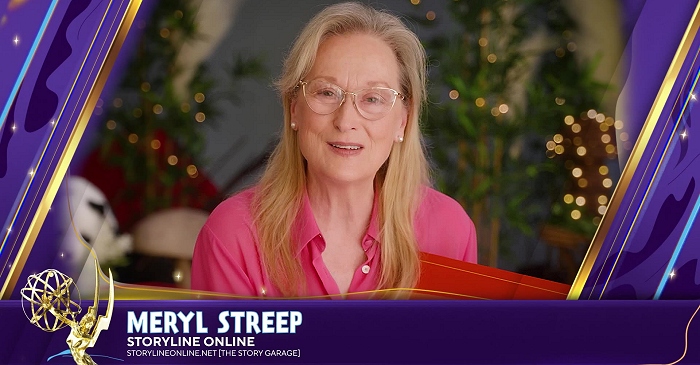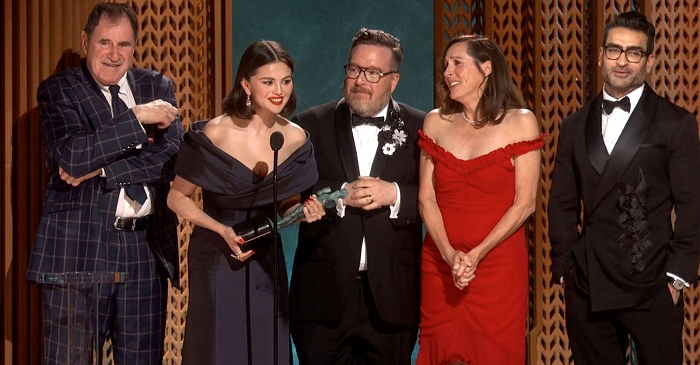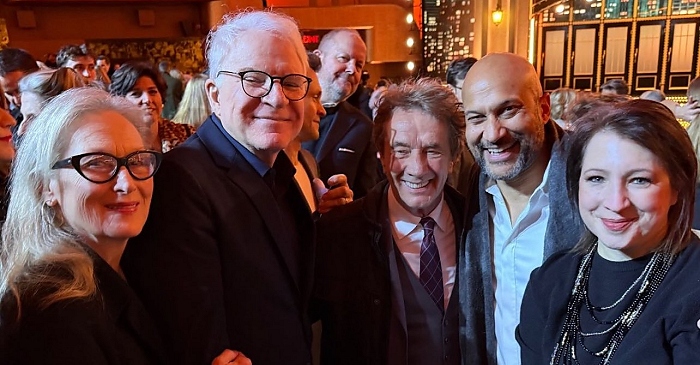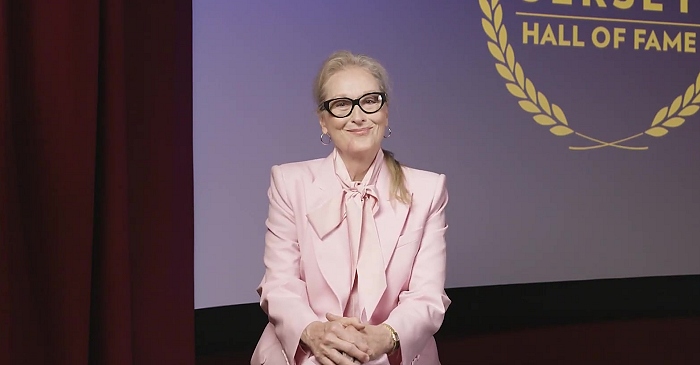|
Simply Streep is your premiere source on Meryl Streep's work on film, television and in the theatre - a career that has won her the praise to be one of the world's greatest working actresses. Created in 1999, we have built an extensive collection to discover Miss Streep's body of work through articles, photos and videos. Enjoy your stay.
|
Celebrating
25 years
of SimplyStreep
|
|
Film Food, Ready for Its "Bon Appetit"
The New York Times ·
July 28, 2009
· Written by Kim Severson
|
When the director Nora Ephron began shooting a pivotal scene in her new movie “Julie & Julia,” it quickly became clear that the sole meunière might become her food stylist’s Waterloo. Julia Child’s first lunch in France centered on Dover sole sputtering in butter sauce. It was, she wrote in her memoir, “the most exciting meal of my life.” For that scene, Ms. Ephron – an accomplished cook who wrote the screenplay, directed the film and personally tested every recipe in the movie except the aspic – would accept nothing short of perfection. “I wanted that sole to look to the audience the way it had looked to Julia when it caused her famous epiphany,” she said. But hey, no pressure.
Susan Spungen, the movie’s food stylist, had spent a dozen years as Martha Stewart’s food editor. She had been a caterer before that. She understood pressure. But she knew she was in the weeds the moment she arrived at a Manhattan restaurant to shoot the scene. For starters, the chef that Ms. Ephron had recruited to cook the sole was instead pressed into service as the scene’s waiter. That left Ms. Spungen uncharacteristically unprepared. The restaurant didn’t have a nonstick pan, and the chef forgot to tell her that the secret to the dish was a light coat of Wondra flour. Worse, she had only about 10 of the expensive fillets to work with. That wouldn’t allow for many mistakes. And even if she cooked one perfectly, how was she going to make sure the big fillet sizzled enough so the camera would pick it up? “I have no idea how, but we finally just got one that didn’t stick,” she said. The sole became Ms. Ephron’s favorite food moment in the film, which opens Aug. 7.
For Ms. Spungen, it is just one of several food miracles in a film where what the actors eat is as important as the actors themselves. Although movies have long relied on half-cooked turkeys colored with motor oil, fruit made of plastic, and ice cream carved from Crisco, food in film is increasingly edible and even delicious. “Everybody thinks it’s all shellacked,” said Colin Flynn, a New York-based chef and stylist who worked with Ms. Spungen on the film. “In the ’70s and ’80s it was more like that. Food looked more like Plasticine. Nowadays it’s almost always real food.” For food stylists, most of whom began as cooks, it’s a welcome change. It’s also good for audiences, who have become more sophisticated about food and expect more realistic images. And directors believe that well-prepared food can improve the actors’ performances and the look of the final scene. “The challenge always is making it seem delicious and hyper-real,” said John Lyons, president of production for Focus Features. “If it doesn’t look hyper-real, it doesn’t work in the movie.”
That means a dish needs to be fresh-looking and well-prepared to begin with, and then enhanced with a bit of oil here and a little fake steam there. On films without the money for a stylist, the props department might rely on a local restaurant or even a crew member’s boyfriend who happens to be a good cook. Mr. Lyons produced “Pieces of April,” about a dysfunctional family Thanksgiving. They had precious few turkeys in the budget. In cases like that, the camera doesn’t linger too long and the actors put as little food in their mouths as possible. But on films with a budget for food stylists, “food becomes very much the fabric of the movie,” he said. “It gets into the celluloid when you have a director who loves food and chefs on the set. It can be quite a delicious experience.” For stylists, the game is all about reading the actors’ appetites and knowing when to employ a few tried-and-true tricks. But really, food styling for movies boils down to doing more prep work than a Hamptons caterer in August.
Mr. Flynn had to debone 60 ducks over the course of “Julie & Julia.” Duck en croûte becomes the crowning glory for Julie Powell, the New York administrative assistant whose 2003 blog about her yearlong effort to cook all the recipes in the first volume of “Mastering the Art of French Cooking” helped inspire the movie. A good stylist always has enough replacement food. That’s not so easy to plan for. Often, no one knows what part of a dish an actor will eat until the scene is shot or how many takes the director will want. So for a scene celebrating Julie’s birthday, Ms. Spungen spent a weekend baking 25 cakes. They used only a fraction of them. Next time, she said, she’ll just buy the layers and frost them on site. Johanna Weinstein, a food stylist based in Toronto, said, “It’s guerilla kind of stuff because you are all about making quantity so the actors have enough of the one thing they have to eat 100 times and then correcting things on the fly.” And things change fast. For the 2000 movie “American Psycho,” Ms. Weinstein had prepared several vegetarian dishes for the actor Willem Dafoe, who, she was told, didn’t eat meat. But at the last minute, he decided his character was a carnivore. In deference to his Method acting technique, she had to send out for steaks and figure out how to cook them on the set.
Even when a little Hollywood magic has to be used, food stylists still try to keep it at least looking real. Two actresses in the 2008 cop thriller “Pride and Glory” were vegan. So Ruth DiPasquale, an assistant property master for the film, called in a vegan chef to help style a big Christmas dinner scene that had a ham as the centerpiece. She ended up piling slices of sham ham made from soybeans near the real stuff, careful to make sure the two versions never touched. Other actors will simply go for it, even if they normally eat no meat or sugar or just don’t like the food called for in the script. “It really depends on what caliber of actor you are dealing with,” said Valerie Aikman-Smith, who has styled food for “Titanic,” “Vanilla Sky” and “Oceans’ Eleven.” “You find that someone like Diane Keaton will just do it and not make a big thing of it at all.” Still, a good food stylist will take care of the actors, whether they are demanding or not. Ms. Spungen made huge bowls full of glossy, cooked Swiss meringue for Ms. Streep to whisk during a scene at Le Cordon Bleu. But she didn’t bother to flavor it with vanilla until she saw that the actress would be dipping a finger into the meringue and popping it into her mouth. “I wanted it to taste good,” Ms. Spungen said. (There was so much left that she turned it into tarts for the crew.)
Chris Messina, who plays Julie Powell’s husband, had a great appetite and never complained, even on the day he had to enthusiastically eat bruschetta topped with tomatoes 36 times. But Ms. Spungen had mercy on him. In another scene, he has to dump salt into a bowl of navarin of lamb during a fight and then eat it. She made sure he was using an off-the-shelf salt substitute. There are a thousand little ways to make it easy on the actors.. Parsley needs to be used sparingly so it doesn’t get stuck in teeth. Toast can’t be so toasty that it crunches too loudly. Low-fat options like apple slices need to be tucked on top of a high-calorie dish that an actor has to nibble on repeatedly. Food stylists also need to know when they can get by with something from a store or a restaurant and when they can’t, and when they can veer off the script a bit and when they can’t. For Ms. Spungen, the lesson came on a cheese platter. Ms. Ephron insisted that a reliably runny and delicious L’Edel de Cleron play the role of a piece of brie Julia Child’s sister eats when she arrives in Paris for a visit. “I really wanted to make a big deal out of brie because one of the clearest food memories I have is when I first had brie after a life of Velveeta,” Ms. Ephron said. That cheese epiphany came when she was 21 and it involved a yellow apple.
The night before the shoot, Ms. Spungen and Mr. Flynn drove all over Manhattan looking for the hard-to-find cheese. They found a little at a Whole Foods, but it wouldn’t be enough. The next day, when they shot at Moutarde in Brooklyn, which served as the set for the cheese scene, they found whole wheels at the nearby Union Market for $19.99 a pound. Of course, there are plenty of times a food stylist has to employ tricks. Cherry pies are filled with mashed potatoes, poultry is partly roasted and painted with Kitchen Bouquet, glycerin and water make beads of sweat on glasses, and ice cream is wrapped around dry-ice nuggets so it won’t melt. When Amy Adams, who plays Ms. Powell in the movie, drops a fruit Bavarian on the sidewalk, she is actually dropping a special breakaway mold filled with whipped cream and raspberry purée. And the stuffing in a chicken that she drops on her kitchen floor had to be doused in heavy cream so it splatted properly. “Believe it or not having the chicken and stuffing land in a certain way in an emotional scene was a challenge,” said Don Lee, an executive producer for the film, who has worked on several Ephron films and shares her love of food.
Making the food look bad is harder than making it look good, food stylists said. After the fight over the lamb stew, Ms. Adams leaves the pot on the stove. To achieve the congealed effect, Ms. Spungen left a batch sitting overnight in a covered Le Creuset pot off the heat. In the morning it looked just as good as it had when it was finished cooking, and she had to leave it out even longer. For another scene, aspic had to be extra loose, colored with Gravy Master and studded with whole chicken livers so it would slither down the sink. Then there are live creatures on a set that must be dealt with properly. On “Titanic,” which was filmed in Mexico, the food was constantly sprayed down with pesticide to keep the flies off. “It can be very unglamorous, really,” said Alison Attenborough, a New York food stylist who worked on the movie. “You still get the grips stealing the sugared almonds, even when you tell them they’ve been sprayed.” On the set of “Julie & Julia,” the lobsters posed a special challenge. Ms. Adams appears to plunge two live lobsters into a pot of steaming water. The steam is actually a cool mist, and just off camera representatives from the American Humane Association monitored the creatures’ health.
All of the effort paid off, Ms. Powell said. “The food is so much prettier than anything I ever made,” she said. “It’s like other aspects of watching your stuff go into the movie. It’s all much prettier than me.”









